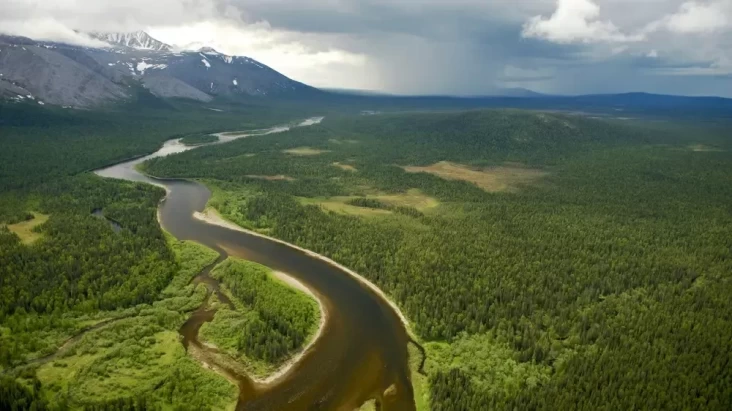Moscow – Forests are more than just vast green landscapes — they are the planet’s natural infrastructure, sustaining life and driving ecological balance. From absorbing carbon and producing oxygen to regulating water cycles and supporting global industries, forests are fundamental to the health of our planet. As climate change intensifies, countries with extensive forest coverage hold a strategic role in shaping global sustainability and environmental resilience.
Russia tops the list as the country with the largest forest area, boasting approximately 815 million hectares, accounting for more than 20% of the world’s total forest cover. Most of Russia’s forests consist of boreal taiga, which serves as the planet’s largest carbon sink. These forests store billions of tons of carbon, helping to stabilize the global climate. However, threats such as illegal logging, wildfires, and climate change continue to challenge Russia’s forest ecosystems.
Brazil ranks second with around 497 million hectares, most of which are part of the Amazon — the world’s largest tropical rainforest. Known as the “lungs of the Earth,” the Amazon produces about 20% of the planet’s oxygen and is home to millions of species. It also plays a critical role in the global water cycle by releasing water vapor that influences rainfall across South America. Yet, deforestation caused by cattle ranching and soybean farming remains a major concern.
In third place, Canada holds approximately 347 million hectares of forest, representing 9% of the world’s total. Its forests range from boreal taiga to coastal rainforests in British Columbia, supporting an exceptional level of biodiversity. Canada is recognized for its sustainable forest management, strict certification systems, and conservation efforts. However, climate-related threats such as pest infestations and large-scale wildfires are rising challenges.
The United States comes next with about 310 million hectares of forest, spread from Alaska’s boreal zones to temperate rainforests in the Pacific Northwest and deciduous forests in the East. American forests are not only ecological assets but also cultural landmarks, deeply tied to the heritage of Indigenous communities. The U.S. leads in reforestation and conservation initiatives, although urban expansion and intense wildfires remain persistent issues.
China ranks fifth with approximately 220 million hectares of forests. Much of this growth is the result of large-scale reforestation projects like the Great Green Wall, aimed at halting the spread of the Gobi Desert. China’s forests range from southern bamboo groves to northern coniferous zones and provide critical habitats for iconic species like the giant panda. Rapid urbanization and industrial activity have historically threatened forest areas, but China is now one of the fastest countries in expanding its forest cover.
In sixth place, the Democratic Republic of the Congo (DRC) covers about 154 million hectares of forest, primarily within the Congo Basin — the second-largest tropical rainforest after the Amazon. Rich in biodiversity, it is home to gorillas, chimpanzees, and okapis. These forests store massive amounts of carbon and support millions of people who depend on non-timber forest products. However, logging, mining, and regional conflicts pose serious threats to their survival.
Australia, with 134 million hectares, ranks seventh and is renowned for its unique eucalyptus forests that support endemic species like koalas and kangaroos. Tropical rainforests in Queensland are among the oldest on Earth. Yet, increasing wildfire incidents and agricultural expansion continue to challenge forest conservation.
Indonesia is eighth with about 92 million hectares of tropical forests, primarily located in Sumatra, Kalimantan, and Papua. These forests are among the most biodiverse on the planet, home to species such as orangutans, Sumatran tigers, and birds-of-paradise. Indonesia’s peatlands also store vast amounts of carbon, making their preservation crucial to climate goals. However, deforestation caused by palm oil plantations, logging, and peatland fires remains a major issue. Recent government initiatives, including a moratorium on new permits for primary forest use, signal a shift toward more sustainable forest governance.
India follows with 72 million hectares (21% of its territory), hosting diverse ecosystems from tropical forests in Kerala to coniferous woodlands in the Himalayas. Forests are vital for local livelihoods, providing timber, fodder, and medicinal plants. Despite urbanization pressures, India is aggressively pursuing reforestation and afforestation programs.
Rounding out the top ten, Peru has around 69 million hectares of forest, mostly part of the Amazon basin. Peru’s forests are rich in biodiversity and have sustained Indigenous communities for millennia. Yet, illegal logging, gold mining, and infrastructure projects are significant threats.
The world’s largest forests — from Russia’s vast taiga to Brazil and Peru’s Amazon rainforests, the Congo Basin, and Indonesia’s tropical ecosystems — are essential to planetary health. But they face mounting threats from deforestation, wildfires, urbanization, and climate change. Safeguarding these “green lungs” of Earth requires not only national policies but also global cooperation, as the future of the planet’s biodiversity, carbon balance, and climate stability depends on them.






